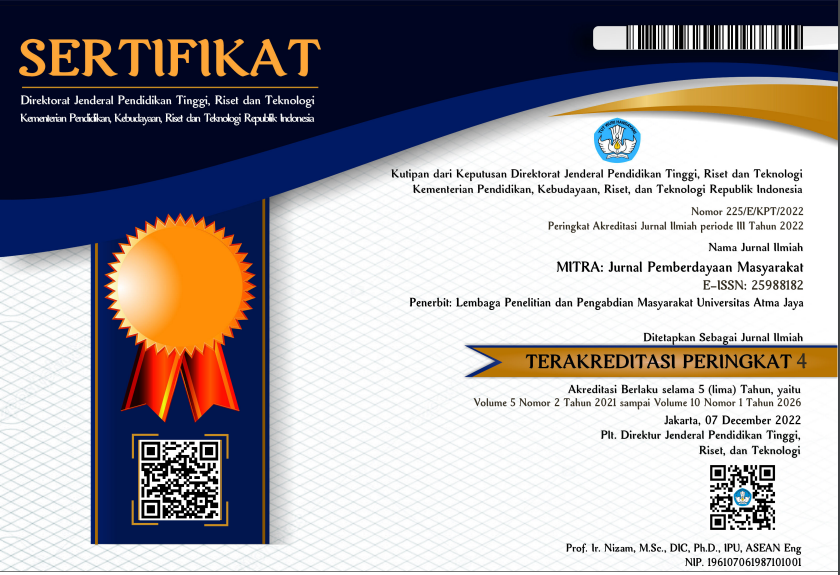Pelatihan Mencampur Warna dan Mewarnai Menggunakan Cat Akrilik Di berbagai Benda
DOI:
https://doi.org/10.25170/mitra.v8i1.4692Keywords:
acrylic paint, aesthetics, colorsAbstract
Paint is a product in the form of liquid or powder which contains coloring substances, and when applied to the surface of an object it forms a layer which has the function of protection, decoration or a special function that is technically required. Visual elements in drawing shape are basic guidelines for draftsman. If the draftsman understands the visual elements in drawing then the image created will be more understandable and in accordance with the drafter’s wishes. Aesthetics as an experience and knowledge becomes a form that is understood as the value of beauty, knowledge of beauty and the beauty of form from an observation of form becomes a beauty. Acrylic paint is a pigment that was first created in the early 20th century by German chemist and entrepreneur Otto Röhm. The first time acrylic paint was available to the general public was in the 1950s. This resin has a wide range of properties, such as excellent water resistance, and exceptional durability when dry, which makes it a perfect material for paint. Coloring activities aim to train skills, neatness and patience. Effective coloring techniques involve mixing colors and knowing contrasting (bright) colors, how to make gradations and shading techniques. From coloring training using acrylic paint, participants already know te 5 pigment-based primary colors and understand various color compositions. Participants are able to mix primary colors to produce secondary colors. Participants are able to color objects from various materials from which they are made. Participants are also able to apply color compositions. Participants are also able to apply color compositions according to their wishes and inspiration.
References
Akbar, M. A. L. I. (N.D.). Pemanfaatan Limbah Kardus Sebagai Media Menggambar Motif Ragam Hias dengan Menggunakan Cat Akrilik pada Siswa Kelas X SMK Gunung Sari Makassar.
Cinthya, A., & Kusuma, H. B. (2018). Meningkatkan Kreativitas Seni Melalui Pelatihan Membuat Karya dengan Memanfaatkan Botol Plastik Bekas. Jurnal Pengabdian Dan Kewirausahaan, 2(1).
Felix, J. (2012). Pengertian seni sebagai pengantar kuliah Sejarah Seni Rupa. Humaniora, 3(2), 614–621.
Ginting, J., & Triyanto, R. (2020). Tinjauan Ketepatan Bentuk, Gelap Terang, dan Warna pada Gambar Bentuk Media Akrilik. Gorga: Jurnal Seni Rupa, 9(2), 300–308.
Purnengsih, I., Andrijanto, M. S., & Rosida, I. (2018). Menggugah Kreativitas Seni Ibu-Ibu PKK melalui Seni Lukis pada Jilbab dalam Rangka Pelestarian Seni. Jurnal PkM (Pengabdian Kepada Masyarakat), 1(03), 244–250.
Riyanti, M. T. (2020). Pelatihan Pemanfaatan Kaleng Bekas Menjadi Produk Bernilai Ekonomi pada Guru Sekolah Luar Biasa di DKI Jakarta. Diseminasi: Jurnal Pengabdian Kepada Masyarakat, 2(2), 64–69.
Rohandi, T., & Listiani, W. (2015). Eksperimen Cat Lukis Pada Kertas Daluang Dari Ekstrak Warna Hijau Pada Famili Daun Suji dan Pandan. ATRAT: Jurnal Seni Rupa, 3(1).
Rustandi, T. (2010). Pintar Melukis dengan Cat Akrilik. WahyuMedia.
Suganda, L., & Jati, S. N. (2019). Pengaruh Pelatihan Menggambar Dengan Teknik Grafitto Terhadap Kreativitas Guru di Raudhatul Athfal Dharma Wanita Persatuan Kantor Wilayah Kementerian Agama Kalimantan Barat. Edukasi: Jurnal Ilmiah Pendidikan Anak Usia Dini, 6(2).
Wiratno, A. T. (2022). Model Seni Mural Perkembangan Lukisan Kontemporer.
Downloads
Published
Issue
Section
License
Copyright (c) 2024 Heru Kusuma

This work is licensed under a Creative Commons Attribution-NonCommercial-ShareAlike 4.0 International License.
This license allows reusers to distribute, remix, adapt, and build upon the material in any medium or format for noncommercial purposes only, and only so long as attribution is given to the creator. If you remix, adapt, or build upon the material, you must license the modified material under identical terms.



_.jpeg)

.png)
2.png)
.png)
.png)



